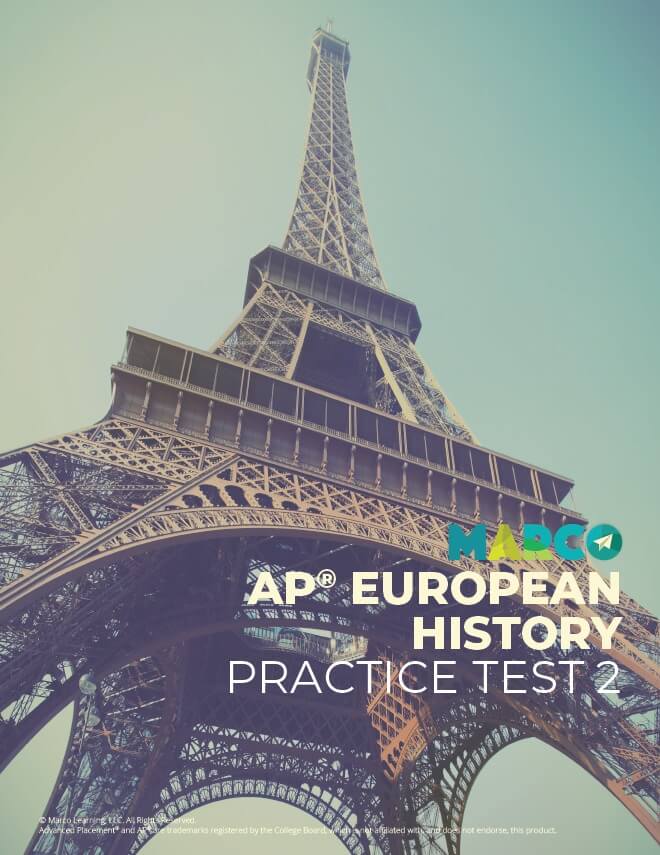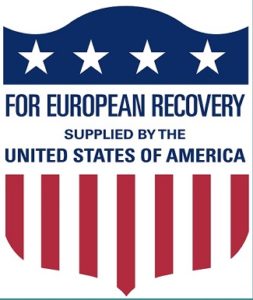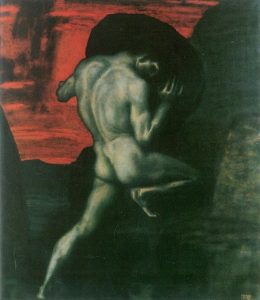


THE COLD WAR
World War II devastated Europe as a result of significant population losses, economic losses, and infrastructure damage. Following the belief that a devastated nation was likely to turn to Communism, the United States offered aid to countries decimated by the war through the Marshall Plan. As a result of this aid package, Western Europe was able to recover quickly from the conflict while Eastern Europe, under Communist control, lagged behind economically. The ideological division between Western and Eastern Europe became increasingly deep-seated and intractable. Winston Churchill argued that Western Europe and Eastern Europe were divided by a metaphorical Iron Curtain that could not be passed.
The West was regulated by NATO, the North Atlantic Treaty Organization, to prevent Soviet aggression. The Warsaw Pact, included the Soviet Union and other Eastern Bloc countries under Soviet control, was the Soviet response to NATO’s defense alliance. While the military forces on both sides of the Iron Curtain did not come to blows within the continent of Europe, they engaged in various “hot wars” in Asia, Latin America, and the Caribbean.

CULTURAL RESPONSE IN POST-WAR EUROPE: EXISTENTIALISM
In the post-war period, existential artists used the ideas of Soren Kierkegaard to argue that objective meaning did not exist. These artists, especially those affiliated with the subset of absurdist art, maintained that each person constructs his or her own meaning for life and the events in it. In Franz Stuck’s painting Sisyphus, for example, Stuck used the myth of Sisyphus’s punishment of endless toil from the gods to argue that life was essentially meaningless. Like Sisyphus’s endless toil, life was tragic and absurd. Existentialism continues to be a popular intellectual movement.

POST-WAR NATIONALISM, ETHNIC CONFLICT, AND ATROCITIES
The nationalist rhetoric that motivated much of the conflict of World War II took on a new form as ethnic minority groups seized the language of popular sovereignty and self-determination to argue for their own distinct sense of nationhood. Nikita Khrushchev’s policies of glasnost and perestroika in the Soviet Union attempted to address this growing movement by changing how the Communist leadership was perceived, but they were ultimately ineffective. Uprisings in Chechnya, Hungary, and Prague challenged Communism and forced Soviet leaders to maintain a hard line against dissent. The USSR continued to face opposition from ethnic groups in its territory until it fell in 1991.
Other countries also experienced the deadly effects of combining nationalism and arguments about ethnic rights. In Yugoslavia, conflict among the Serbs, Bosnians, and Croatians resulted in the ethnic cleansing of the Bosnian Muslims. In Spain, nationalists formed the separatist group ETA, which used violence in its unsuccessful attempt to develop a nation based on Basque culture and language.
EUROPE AND THE WORLD
The end of World War II also prompted a widespread reconsideration of Europe’s place in the world and the role of colonized people in determining their own political and social trajectories. Much of the rhetoric of national self- determination that dominated the post-war period can be traced back to Woodrow Wilson’s proposals as part of the Treaty of Versailles that ended World War I. Following World War II, however, these ideas began to gain global traction. In some countries, such as India, the decolonization process was accomplished through peaceful means. In others, such as Vietnam, local resistance to European colonialism led to armed conflict. Cold War strategic alliances complicated the decolonization process in many places because European countries resisted giving up what they perceived as bulwarks against the spread of Communism.
Within Europe itself, European nations addressed the idea of national identity through the formation of the European Union, a shared economic system that supported the free movement of people across Europe.
CAUSATION
Following World War II, intractable differences emerged between capitalist Western Europe and communist Eastern Europe. The ideological Iron Curtain dividing East and West was never challenged by a “hot” war in Europe, but the two sides fought through “proxy wars,” propaganda, and covert actions.
The Cold War complicated the decolonization process, but nationalist movements in many colonies successfully campaigned for freedom from foreign rule. The sharp divisions of the Cold War broke down as the world became increasingly interconnected.
GLOBALIZATION
During the post-war era, new ways of thinking about the world and the people in it led to widespread reevaluation of social and cultural norms. In gender theory, a new wave of feminism challenged women’s roles in society. Simone de Beauvoir, who wrote The Second Sex, used a historical point of view to argue that the West historically privileged men and that a new, global, post-war world needed to include new models of womanhood and family life.
Conversations that challenged the foundations of society in the post-war world were possible because of technologies that effectively linked communities across the globe. Technological advances, such as the development of the Internet and cell phones, had positive and negative consequences. Medical technologies in particular proved to be especially divisive as technological innovations led to social and moral questions around birth control, abortion, and genetic engineering. These conversations were complicated by the continued influence of organized religion, which maintained a role in European social and cultural life. Constant technological innovation contributed to consumerism, which had significant environmental impacts.
TIMELINE
1948 The Marshall Plan passes the U.S. Congress. The Marshall Plan provided over $12 billion in aid to nations in Western Europe affected by World War II.
1980 Solidarity is founded in Poland. Solidarity was a major challenge to Soviet authority in the Eastern Bloc. By accepting some of Solidarity’s demands, the Soviet government demonstrated that there were limits to their power.
1989 The Berlin Wall falls, signaling the impending end of the Soviet Union.
1992 The European Union is formed through the Maastricht Treaty.
1999 The Euro is introduced as the common currency of the European Union.
The best way to get better at something is by practicing.
That’s why it’s so important that you take practice tests to help you get better at the AP European History Exam. Only then can you expect to get a good score—and even improve your score.
Download your free AP® European History practice test HERE.
Download your printable study guides for all of the units for AP European History HERE.
 Help
Help